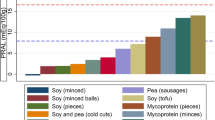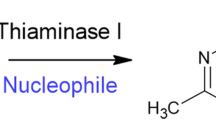Abstract
NUMEROUS reports attest to the occurrence of thiamine deficiency in furbearing animals due to destruction of the dietary source of the vitamin by thiaminase activity. Fresh-water fish were first implicated as sources of the thiaminase enzyme, and their presence as major diet ingredients for foxes led to the definition of characteristic thiamine deficiency symptoms as ‘Chastek paralysis’1–3. Ranch mink fed similar rations developed corresponding symptoms4,5. Extension of the diet sources used with mink led to the recognition that marine fish might also be troublesome as contributors of thiaminase activity6 and at present a number of different fish species are listed as containing significant amounts of thiaminase. These have been assembled by Harris7, who reports 28 fresh-water and 8 salt-water fish species as thiaminase-active.
This is a preview of subscription content, access via your institution
Access options
Subscribe to this journal
Receive 51 print issues and online access
$199.00 per year
only $3.90 per issue
Buy this article
- Purchase on Springer Link
- Instant access to full article PDF
Prices may be subject to local taxes which are calculated during checkout
Similar content being viewed by others
References
Green, R. G., Minn. Wildlife Dis. Invest., 2, 106 (1936).
Green, R. G., Minn. Wildlife Dis. Invest., 3, 83 (1937).
Green, R. G., Minn. Wildlife Dis. Invest., 3, 173 (1937).
Ender, F., and Helgebostad, A., Skand. Vet. Tidskr., 29, 1232 (1939).
Swale, F. S., Amer. Fur Breeder, 14, 20 (1941).
Long, J. B., and Shaw, J. N., N. Amer. Vet., 24, 234 (1943).
Harris, R. S., in The Enzymes, edit. by Sumner, J. B., and Myrback, K., 1, Pt. 2 (Academic Press, New York, 1951).
Stout, F. M., Oldfield, J. E., and Adair, J., J. Nutr., 70, 421 (1960).
Stout, F. M., Oldfield, J. E., and Adair, J., J. Nutr., 72, 46 (1960).
Deutch, H. F., and Hasler, A. D., Proc. Soc. Exp. Biol. and Med., 53, 63 (1943).
Yudkin, W. A., Proc. Soc. Exp. Biol. and Med., 60, 268 (1945).
Jones, W. G., Fishery Leaflet 501, Bureau of Comm. Fish., Fish and Wildlife Serv., Dept. of Interior 228 (1960).
Neilands, J. B., J. Fisheries Res. Board Canad., 7, 94 (1947).
Green, R. G., Evans, C. A., Carlson, W. E., and Swale, F. S., J. Amer. Vet. Med. Assoc., 100, 394 (1942).
Author information
Authors and Affiliations
Rights and permissions
About this article
Cite this article
STOUT, F., OLDFIELD, J. & ADAIR, J. A Secondary Induced Thiamine Deficiency in Mink. Nature 197, 810–811 (1963). https://doi.org/10.1038/197810a0
Issue Date:
DOI: https://doi.org/10.1038/197810a0
Comments
By submitting a comment you agree to abide by our Terms and Community Guidelines. If you find something abusive or that does not comply with our terms or guidelines please flag it as inappropriate.



